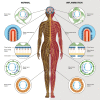The Importance and Control of Low-Grade Inflammation Due to Damage of Cellular Barrier Systems That May Lead to Systemic Inflammation
- PMID: 31191433
- PMCID: PMC6549124
- DOI: 10.3389/fneur.2019.00533
The Importance and Control of Low-Grade Inflammation Due to Damage of Cellular Barrier Systems That May Lead to Systemic Inflammation
Abstract
Systemic low-grade inflammation can be initiated in vivo after traumatic injury or in chronic diseases such as neurodegenerative, metabolic, and autoimmune diseases. Inducers of inflammation trigger production of inflammatory mediators, which alter the functionality of tissues and organs and leads to harmful induction of different barrier systems in the body, where the blood-brain barrier, the blood-retinal barrier, blood-nerve barrier, blood-lymph barrier and the blood-cerebrospinal fluid barrier play major roles. The different barriers are unique but structured in a similar way. They are equipped with sophisticated junctional complexes where different connexins, protein subunits of gap junction channels and hemichannels, constitute important partners. The cells involved in the various barriers are coupled in networks, are excitable but do not express action potentials and may be targets for inflammation leading to changes in several biochemical cellular parameters. During any type of inflammation barrier break-down is observed where any form of injury can start with low-grade inflammation and may lead to systemic inflammation.
Keywords: blood-brain barrier; blood-cerebrospinal fluid barrier; blood-lymph barrier; blood-nerve barrier; blood-retinal barrier; low-grade inflammation; systemic inflammation.
Figures

Similar articles
-
Low-grade inflammation causes gap junction-coupled cell dysfunction throughout the body, which can lead to the spread of systemic inflammation.Scand J Pain. 2019 Jun 28;19(4):639-649. doi: 10.1515/sjpain-2019-0061. Print 2019 Oct 25. Scand J Pain. 2019. PMID: 31251727
-
Coupled cell networks are target cells of inflammation, which can spread between different body organs and develop into systemic chronic inflammation.J Inflamm (Lond). 2015 Jul 25;12:44. doi: 10.1186/s12950-015-0091-2. eCollection 2015. J Inflamm (Lond). 2015. PMID: 26213498 Free PMC article. Review.
-
Role of Hemichannels in CNS Inflammation and the Inflammasome Pathway.Adv Protein Chem Struct Biol. 2016;104:1-37. doi: 10.1016/bs.apcsb.2015.12.001. Epub 2015 Dec 31. Adv Protein Chem Struct Biol. 2016. PMID: 27038371 Review.
-
Structural pathways for macromolecular and cellular transport across the blood-brain barrier during inflammatory conditions. Review.Histol Histopathol. 2004 Apr;19(2):535-64. doi: 10.14670/HH-19.535. Histol Histopathol. 2004. PMID: 15024715 Review.
-
A new angle on blood-CNS interfaces: a role for connexins?FEBS Lett. 2014 Apr 17;588(8):1259-70. doi: 10.1016/j.febslet.2014.02.060. Epub 2014 Mar 12. FEBS Lett. 2014. PMID: 24631535 Review.
Cited by
-
Exploring the Pathophysiology of Long COVID: The Central Role of Low-Grade Inflammation and Multisystem Involvement.Int J Mol Sci. 2024 Jun 9;25(12):6389. doi: 10.3390/ijms25126389. Int J Mol Sci. 2024. PMID: 38928096 Free PMC article. Review.
-
Editorial: Smoldering Inflammation in Cardio-Immune-Metabolic Disorders.Front Physiol. 2021 Mar 19;12:651946. doi: 10.3389/fphys.2021.651946. eCollection 2021. Front Physiol. 2021. PMID: 33868019 Free PMC article. No abstract available.
-
Microvascular Dysfunction in Diabetes Mellitus and Cardiometabolic Disease.Endocr Rev. 2021 Jan 28;42(1):29-55. doi: 10.1210/endrev/bnaa025. Endocr Rev. 2021. PMID: 33125468 Free PMC article. Review.
-
Endocrinological and inflammatory markers in individuals with spinal cord injury: A systematic review and meta-analysis.Rev Endocr Metab Disord. 2022 Oct;23(5):1035-1050. doi: 10.1007/s11154-022-09742-9. Epub 2022 Aug 18. Rev Endocr Metab Disord. 2022. PMID: 35978214 Free PMC article.
-
Impaired glucose metabolism reduces the neuroprotective action of adipocytokines in cognitively normal older adults with insulin resistance.Aging (Albany NY). 2021 Nov 3;13(21):23936-23952. doi: 10.18632/aging.203668. Epub 2021 Nov 3. Aging (Albany NY). 2021. PMID: 34731089 Free PMC article.
References
Publication types
LinkOut - more resources
Full Text Sources
Miscellaneous

